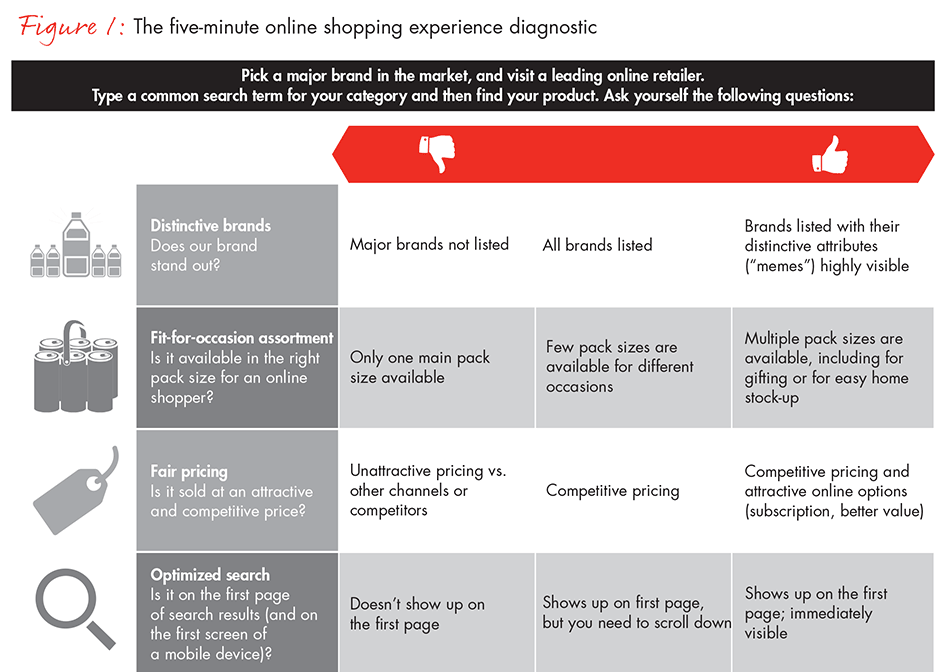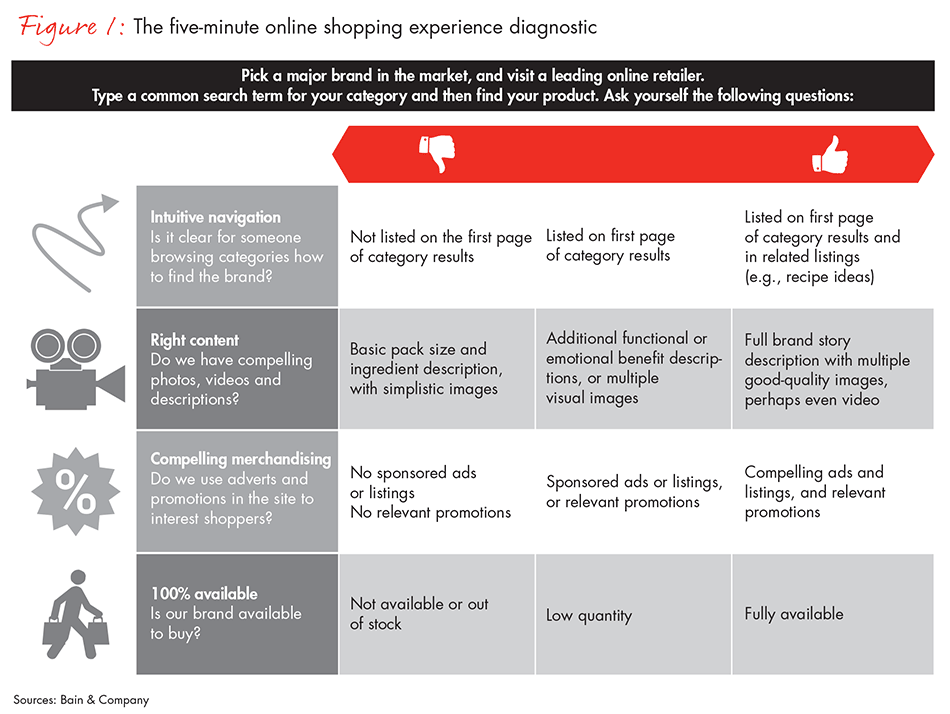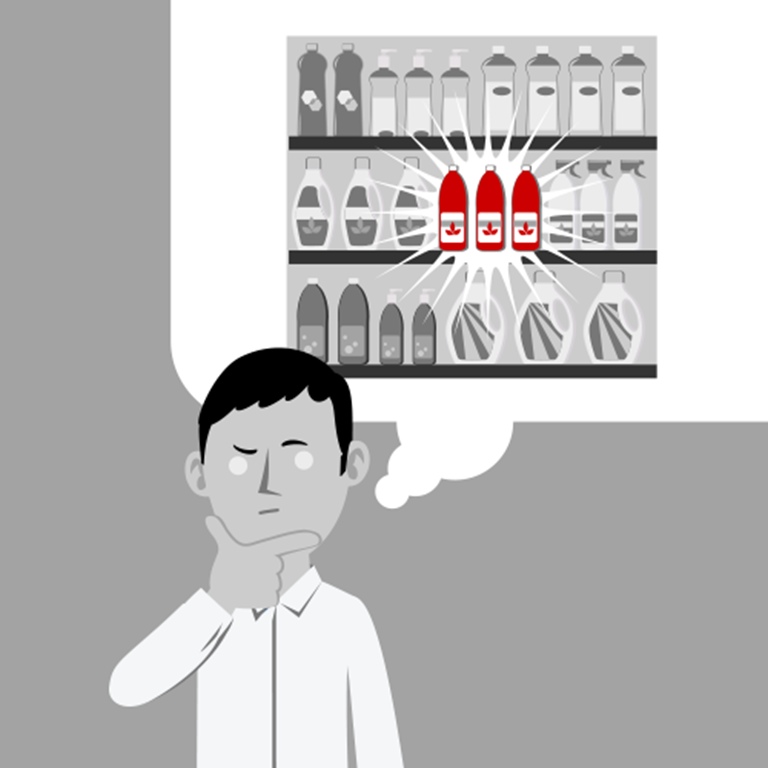Brief

More and more consumers are opting for the convenience of purchasing on their smartphones or laptops than shopping in stores. Yet the reality is that despite the growing importance of digital commerce, many established fast-moving consumer goods (FMCG) companies still don’t have a well-funded plan in place to seize the opportunity. They’re struggling to win online.
There are some standouts. Procter & Gamble understood the potential of digital commerce early in the game, and made it a core element of its growth strategy. Similarly, Unilever, which is watching its online sales grow at twice the rate of the global e-commerce market, has quickly adapted to the unique needs of the digital marketplace by investing in the right capabilities. These companies are not only holding their own, they’re actually pulling away from the pack. They’re capturing growth in booming digital commerce channels amid tough competition from young, nimble and digitally savvy insurgents such as Harry’s and Birchbox, which are leapfrogging many traditional players in digital capabilities.
There’s a great deal at stake. No doubt about it, the majority of future growth for many brands will come from digital commerce. Online grocery sales alone are projected to top $90 billion by 2020. To appreciate the dimensions—and potential—of digital commerce, look no further than Singles’ Day, China’s annual, promotions-heavy, 24-hour online-sales event, which generated $17.8 billion for Alibaba sites in 2016 alone—more than Whole Foods’ total annual revenue. Sales of FMCG represented a sizeable portion of Alibaba’s revenue.
But the big question is: How can established brands reap the biggest rewards from this dramatic online activity? Based on our extensive market analysis and interviews with small and large consumer products companies, we’ve identified four key steps that will enable brands to get ahead in the digital commerce race.
Richard Webster, a partner with Bain's Consumer Products practice, outlines four things companies can do to ensure success in digital commerce.
Return to strategy. The most successful online brands view the emergence of digital commerce as an opportunity to redefine their overall strategy. But, there are some fundamental reasons why so many companies lag behind on strategy. They make small, incremental bets but never bold choices. As a result, they’re continually investing behind the curve. They also treat digital as just another channel, rather than an opportunity to revisit what drives shoppers and retailers—and to inform their strategic direction. And, they assign junior members to their digital team instead of acknowledging that success requires steady involvement from top leadership. That’s why companies like P&G tasked their most senior executives with investment choices and laying out priority actions for the organization. Among P&G’s pioneering digital moves were an early partnership with Amazon, subsequent partnerships with leading digital retailers, such as Alibaba’s Tmall, and experimentation with direct-to-consumer offerings.
Define priority micro battles. There’s nothing democratic about digital commerce. Some product categories lend themselves to digital commerce more than others, and some markets are more embracing of it than others. The reality is that for many product categories, few business models and relatively few geographies will move the needle. Leaders invest to identify the large and important growth opportunities. To really drive a difference in sales could mean cracking Amazon in the UK and the US or focusing on Alibaba in China. In fact, four markets often account for up to 80% of online sales for categories we’ve studied: China, France, the UK and the US.
It’s best not to minimize your impact by spreading your investments too thin. Instead, zero in on the most promising battles, armed with solid research on consumers’ and retailers’ behavior. Based on our experience, leading companies take a systematic approach when choosing where to invest to deliver value—deciding on the geographies first, then the categories, then the business models.
Choosing a geography requires understanding the vast distinctions among digital commerce markets. Consumer behavior and the channel landscape are significantly different in Malaysia and neighboring Thailand, for example. Malaysia has a high e-commerce penetration (65%) compared with its Internet penetration (68%). Thailand, on the other hand, has low penetration in both: an Internet penetration of 42% and an e-commerce penetration of around 20%. However, a deeper dive shows that companies have the opportunity to increase the average revenue per user in Malaysia, which at $203 is much lower than that in Thailand, at $684.
After understanding the overall channel landscape, the next step is determining whether there’s a propensity for purchasing your particular category online and, if so, what influences shoppers’ behaviors. For example, Malaysian shoppers are more willing than their Thai counterparts to buy packaged food online, according to Bain & Company’s 2016 survey on e-commerce in Southeast Asia. The next decision: What’s the right business model for the market and category? For instance, is it better to go with Lazada, the dominant retail pure play in the region vs. a country-specific, single-category specialty site vs. establishing a direct-to-consumer presence?
When selling in China, the micro-battle approach might help a company hone its activities to boost the odds of success. Rather than trying to sell all brands in China, a company could invest to understand the types of promotions that have been most successful for a particular product category during Singles’ Day—and replicate the winning approaches. Then, the plan could be tailored based on whether a retail channel is a click-and-mortar retailer like Walmart, a pure play like Amazon or Tmall, or a direct-to-consumer site like Nestle.com—and whether it is a multicategory generalist site or single-category specialist site.
Perfect the online shopping experience. We all know the importance of shelf activation. But what happens when a customer doesn’t come into a store? In digital commerce, the screen is your shelf. And there are fewer slots that are usually filled by digital trailblazers— since digital favors first movers. Many people assume the shelf online is bigger, but a mobile screen can only hold a handful of products. And unlike a grocery store, there are no merchandising guideposts—detailed planograms or end caps, for example. This changes the nature of how shoppers consider, find and select your brands—and you will need to adapt.
Consumer products companies hoping to win online need to determine how digital influences shopper behavior in their respective categories. Our research shows that the main reason people shop online in many categories is for convenience, not value. The trouble is, too many sites and their FMCG partners fail to provide a convenient customer experience at every touchpoint, from considering products to finding, buying and receiving them.
All online shoppers have been subjected to overly complicated website displays, confusing checkout processes, unresponsive mobile sites and other challenges. Turned off, they shift to a more user-friendly competitor. In business-to-business-to-consumer (B2B2C) situations, the retailer controls the overall user experience, but the manufacturer can make a significant difference. That’s what Unilever did when it set out to tackle one of its biggest online challenges: improving the way its products were displayed on mobile phones. The company’s initiative to produce better images on small screens has been cited as a key factor in its huge digital commerce success. With direct-to-consumer models, the manufacturers can play an even greater role.
Some elements of the user experience are objective and can be tracked, measured and improved. We find that the best companies develop a scorecard so they can monitor the online customer experience—such as the brand’s ranking in search results, the level of stock-outs and the quality of product images—and generate a daily report that can guide ongoing improvement. There are subjective elements of the customer experience, too. The best companies track shoppers’ follow-through, conversion rates and bounce-back rates. They use a range of tools, often in partnership with a retailer, to follow a shopper’s online behavior. There’s a lot to learn by analyzing the precise moment that a customer leaves a site. Brands also determine where the experience is especially effective—which images are particularly convincing, for example.
With evidence of what works—and what doesn’t—companies can adapt their online presence across the three dimensions of the shopping experience: consider, find and buy. To encourage consideration, companies need to offer distinctive brands, fit-for-occasion assortment and fair pricing. To help shoppers find what they want, brands need to enable an optimized search experience, intuitive navigation and compelling merchandise. Finally, to convince shoppers to buy, brands need to ensure products are 100% available, with the right product content and flawless service and delivery. We have created a quick diagnostic to help companies assess their brands (see Figure 1).


The encouraging news is that it’s much easier to stay on top of shoppers’ behaviors online than in the physical world. While it may be a challenge to determine how much time a shopper spends in a store aisle, it’s extremely simple to track how many seconds they hover over an image. In the digital realm, it’s also much easier to make changes and conduct regular test-and-learn experiments—swapping out an image that’s not effective, for instance—than it is in a brick-and-mortar store.
And in some markets, there’s an extra challenge. In addition to getting customers to buy their products, consumer goods companies need to get products to consumers, as some online retailers—particularly in developing economies—require consumer goods companies to provide last-mile delivery.

Is Your Brand Positioned to Win in Digital?
With more shoppers buying on digital channels, here are four ways that brands can get ahead.
Sprint toward results in each battle. This is a race that is being won by the swift. Start-ups like China’s Three Squirrels are setting the pace. The young and overwhelmingly successful online seller of nuts built its brand around three animated squirrels, each of which interacts with customers (“owners”) who buy (“adopt”) the product over WeChat. Each box of nuts contains a wet tissue, a bag for disposing shells and a nut cracker, if necessary. This is what innovation looks like today. A key reason that new companies like Three Squirrels are able to gain—and keep—a lead over incumbents: They do a better job of innovating. For example, to spur innovation they break down the silos that inhibit sharing data and ideas across marketing, sales, product development, packaging and other functions.
In any country, traditional enterprises competing with such innovation can no longer move at their usual glacial pace. Instead, they need to adopt Agile approaches—replacing annual planning cycles with shorter cycles and spending no more than four weeks from idea to product launch, and replacing function-by-function engagement with a single Agile team and live customer testing.
We find that the most effective Agile innovators spend 10% to 15% of their marketing budget on test-and-learn digital marketing. Snack producer Graze’s factory is designed to launch a new product in 48 hours, allowing fast response to customer feedback. Similarly, a key ingredient of Hotel Chocolat’s success is its ability to adapt products based on real-time feedback from the 70,000 members of its tasting club.
There are other important actions to consider in implementing a digital commerce strategy. Leading brands ensure they have the right organizations to deliver on their strategy. This means developing new guiding principles for adjusting their operating models. They also know that success in digital commerce requires careful attention to managing channel conflict, particularly around pricing or direct-to-consumer moves. Indeed, consumer goods companies must understand the impact of their digital commerce strategy on other channels. But, while it’s never a good thing to ignore the trade-offs, it’s also important not to be overly concerned about them.
Above all, the digital commerce leaders, both traditional companies and insurgents alike, share one big trait that separates them from laggards: They have senior executives who eagerly embrace the digital future of commerce—as opposed to merely enduring it.
Richard Webster is a Bain & Company partner in London and a member of the firm’s Consumer Products practice. Mike Booker is a partner in Singapore; he leads Bain’s Consumer Products practice in the Asia-Pacific region. Suzanne Tager is the senior director of Bain’s Retail and Consumer Products practices in the Americas and is based in New York.

